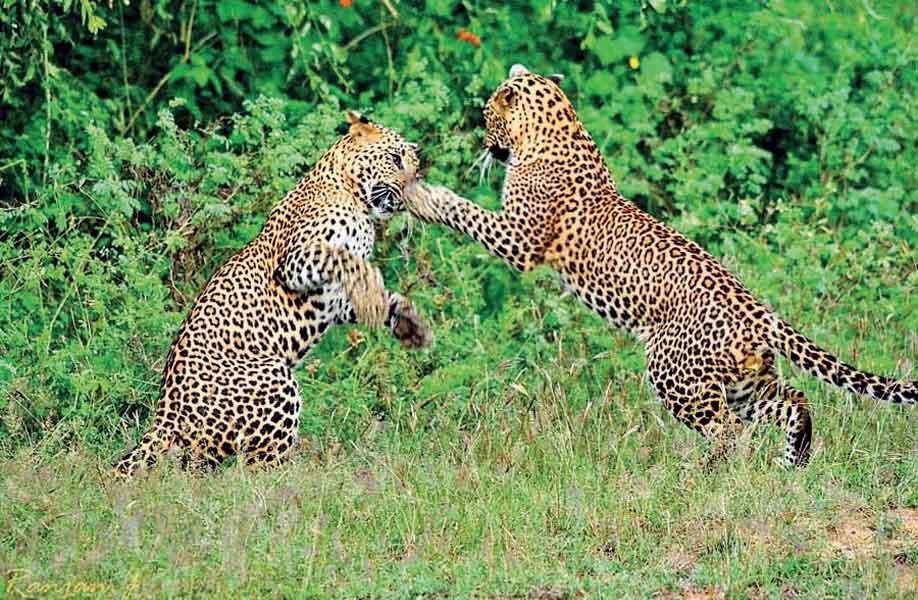09 Oct 2024 - {{hitsCtrl.values.hits}}

For the adventurous traveller, Yala is not just a destination; it’s an invitation to connect with one of nature’s most enigmatic creatures. Exploring the park’s rugged beauty, with the hope of catching a glimpse of the elusive leopard, is an experience that brings you closer to the untamed heart of Lanka’s wilderness
 When people talk about Sri Lankan wildlife, elephants often take centre stage. Yet, there’s another remarkable creature that deserves more attention – the Sri Lankan leopard, the island’s only big cat and a symbol of untamed wilderness. While efforts to conserve elephants are widely recognised, the importance of protecting this elusive predator is often overlooked.
When people talk about Sri Lankan wildlife, elephants often take centre stage. Yet, there’s another remarkable creature that deserves more attention – the Sri Lankan leopard, the island’s only big cat and a symbol of untamed wilderness. While efforts to conserve elephants are widely recognised, the importance of protecting this elusive predator is often overlooked.
 The Sri Lankan leopard (Panthera pardus kotiya) is not just any big cat; it is a unique subspecies that has roamed the island for thousands of years. Isolated from other large carnivores, these leopards have evolved distinct behavioral traits, making them fascinating to observe for wildlife enthusiasts. And where better to catch a glimpse of this stunning animal than in the wilds of Yala National Park specially Blocks 1 and 2, a destination that has become synonymous with leopard sightings.
The Sri Lankan leopard (Panthera pardus kotiya) is not just any big cat; it is a unique subspecies that has roamed the island for thousands of years. Isolated from other large carnivores, these leopards have evolved distinct behavioral traits, making them fascinating to observe for wildlife enthusiasts. And where better to catch a glimpse of this stunning animal than in the wilds of Yala National Park specially Blocks 1 and 2, a destination that has become synonymous with leopard sightings.
Yala, covering over 1,297 square kilometers, is Sri Lanka’s most famous national park. With its diverse landscapes – ranging from dry monsoon forests and thorny scrublands to freshwater wetlands and sandy beaches – it provides a rich habitat for leopards and countless other species. The park is divided into several blocks, with Yala Blocks 1 and 2 being particularly famous for leopard sightings. Recently, with the opening of the beautiful Kumana National Park and Yala East, access to prime leopard territory has become even easier for travellers eager to witness the grandeur of this big cat. For those seeking a thrilling safari experience, Yala’s dense concentration of leopards offers a higher chance of encountering one than almost anywhere else in the world. The park’s topography, from the flowing waters of Menik Ganga to the winding tributaries of Kumbukkan Oya, creates ideal conditions for the leopards, even in the dry season. As leopards silently stalk through the park’s ecosystems, from the dense forest canopies to open grasslands, they remain masters of stealth and surprise, making each sighting a breathtaking moment.

Image courtesy: WNPS
Leopards are renowned for their adaptability, thriving in environments as varied as deserts, jungles, and even areas close to human settlements. However, this adaptability comes with challenges. Over the years, as human populations expand into leopard territory, conflicts between humans and these majestic creatures have become more common. Places like Hantane, Haldumulla, and Haputale have seen instances where leopards, pushed by habitat loss, have begun preying on domestic animals like dogs, sparking concerns about human-wildlife conflict.
|
Image courtesy: WNPS
|
While Yala remains the heartland of leopard activity in Sri Lanka, it’s disheartening to note that little comprehensive research has been done on the island’s leopard population. The late Dr. Ravi Samarasinghe, often hailed as the ‘father of leopard studies’ in Sri Lanka, dedicated years to documenting these elusive creatures in Yala, using their unique facial spot patterns to identify individual leopards. His contributions were pivotal, and he even served as a consultant for BBC documentaries highlighting the lives of Yala’s leopards. However, despite these efforts, there is still no official estimate of the island’s total leopard population.
For travellers with a love for the wild, a visit to Yala offers more than just a chance to see leopards. The park’s ecosystems are home to a wide variety of species, from elephants and sloth bears to rare birds and reptiles.
Each safari through its diverse terrains offers the potential for unforgettable encounters, with the leopard being the crown jewel of the experience.
But beyond the thrill of sighting a leopard in its natural habitat, travellers are also reminded of the importance of conservation. As top predators, leopards play a critical role in maintaining the balance of ecosystems. They control populations of herbivores, which, if left unchecked, could decimate plant life and disrupt the natural balance. Without these graceful hunters, Sri Lanka’s wild landscapes would change dramatically.

For the adventurous traveller, Yala is not just a destination; it’s an invitation to connect with one of nature’s most enigmatic creatures. Exploring the park’s rugged beauty, with the hope of catching a glimpse of the elusive leopard, is an experience that brings you closer to the untamed heart of Lanka’s wilderness.
04 Dec 2024 31 minute ago
04 Dec 2024 2 hours ago
04 Dec 2024 2 hours ago
04 Dec 2024 2 hours ago
04 Dec 2024 3 hours ago